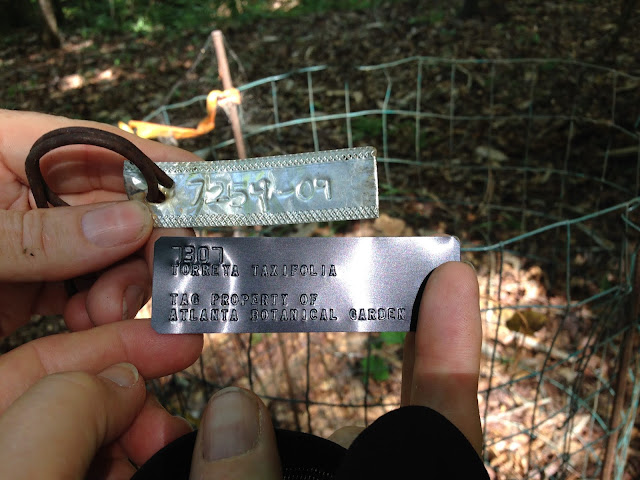On December 5th, Florida Native Plant Society (FNPS) Executive Director Juliet Rynear joined staff from the Atlanta Botanical Garden (ABG) and volunteers from FNPS, Jacksonville Zoo, and Jacksonville Arboretum to monitor Florida Torreya trees in
Torreya State Park, near Bristol. This was just 1 day in a week-long monitoring expedition that takes place annually on public property where this rare tree occurs.
The FNPS TorreyaKeepers project is focused on working with private landowners to locate and conserve trees on private property. This project will expand upon the work that ABG is doing and help to conserve more of the genetic diversity of Florida Torreya. Currently, we are working on a brochure to help private landowners identify Florida Torreya and distinguish it from other similar-looking trees. We will also be developing a brochure on best management practices to help private landowners protect the species on their properties.
 |
| Each tree is assigned a unique number on a “dog tag” in addition to an Aluminum tag that records the year that the tree was located and tagged.
Photo by Leigh Brooks. |
Florida Torreya (Torreya taxifolia), is North America's most endangered conifer and its habitat is the steep ravines of the of the Apalachicola River in north Florida and for about 1 mile into southern Georgia. Since the 1950’s, the species has been threatened by numerous fungi. Most trees found in the wild are actually root sprouts that are just a few feet tall. This is due to stem and needle blights caused by the fungi.
 |
| TorreyaKeepers volunteer
Scott Copeland beginning a steep descent into a ravine at Torreya State Park. |
Each tree that is located is given a unique number so that data can be collected over time. Data are recorded for tree height, tree condition, canopy density, and soil moisture. Additionally, habitat conditions within a 10-meter radius around each tree are documented. This is especially important following Hurricane Michael because we are concerned that increased sunlight may damage Torreya trees. Part of the habitat data is downloaded from Hobo data loggers which are affixed to nearby trees and record temperature and humidity every 6 hours. The data are then downloaded to ABG staff cell phones when they're monitoring the trees.
 |
| Laurie Blackmore of ABG records monitoring data in Torreya State Park. Photo by Juliet Rynear. |
Most trees are also caged to prevent deer from rubbing their antlers on the trees, which would stress the trees in addition to providing a vector for the spread of harmful fungi to other trees that the deer may visit.
 |
| A volunteer uses a densiometer to gather canopy data. |
On one of the monitoring days, a crew located a previously-undocumented tree in the park while they were clambering up and down the ravines to locate the tagged trees. It is always exciting to find another rare Torreya tree!
 |
| Sunburned tree in full sun at a botanical garden. Photo by Juliet Rynear. |
Instructions on caging the trees to protect from deer browse and rub are on the
TorreyaKeepers website and landowners who have Torreya or would like us to survey their property should email torreyakeepers@fnps.org.
Are you interested in Torreya? Want to help this highly imperiled tree? Check out our
You Can Help page.
TorreyaKeepers Flickr Album








Comments
https://californiabigtrees.calpoly.edu/tree-detail/torreya-californica/396
https://californiabigtrees.calpoly.edu/tree-detail/torreya-californica/396